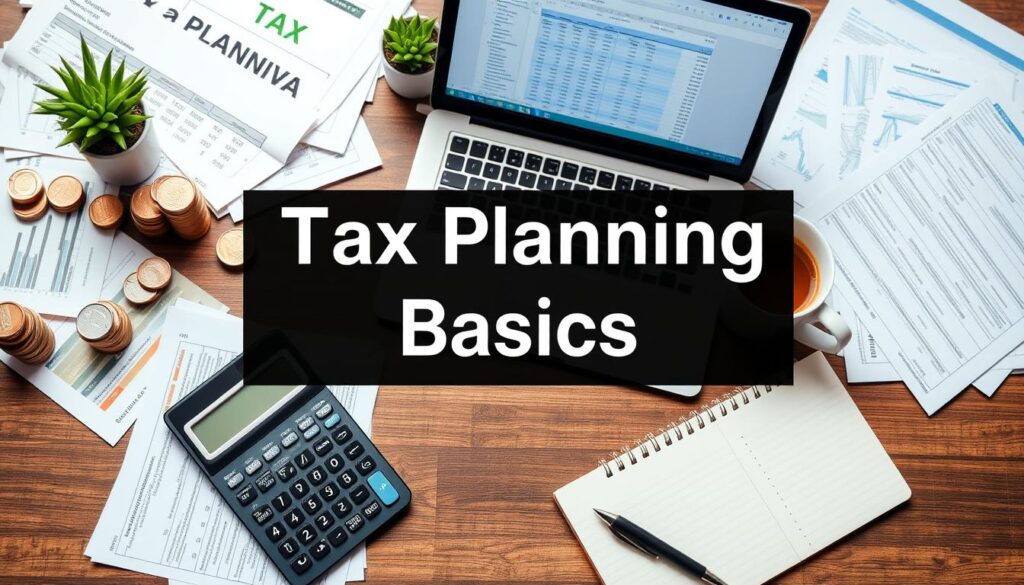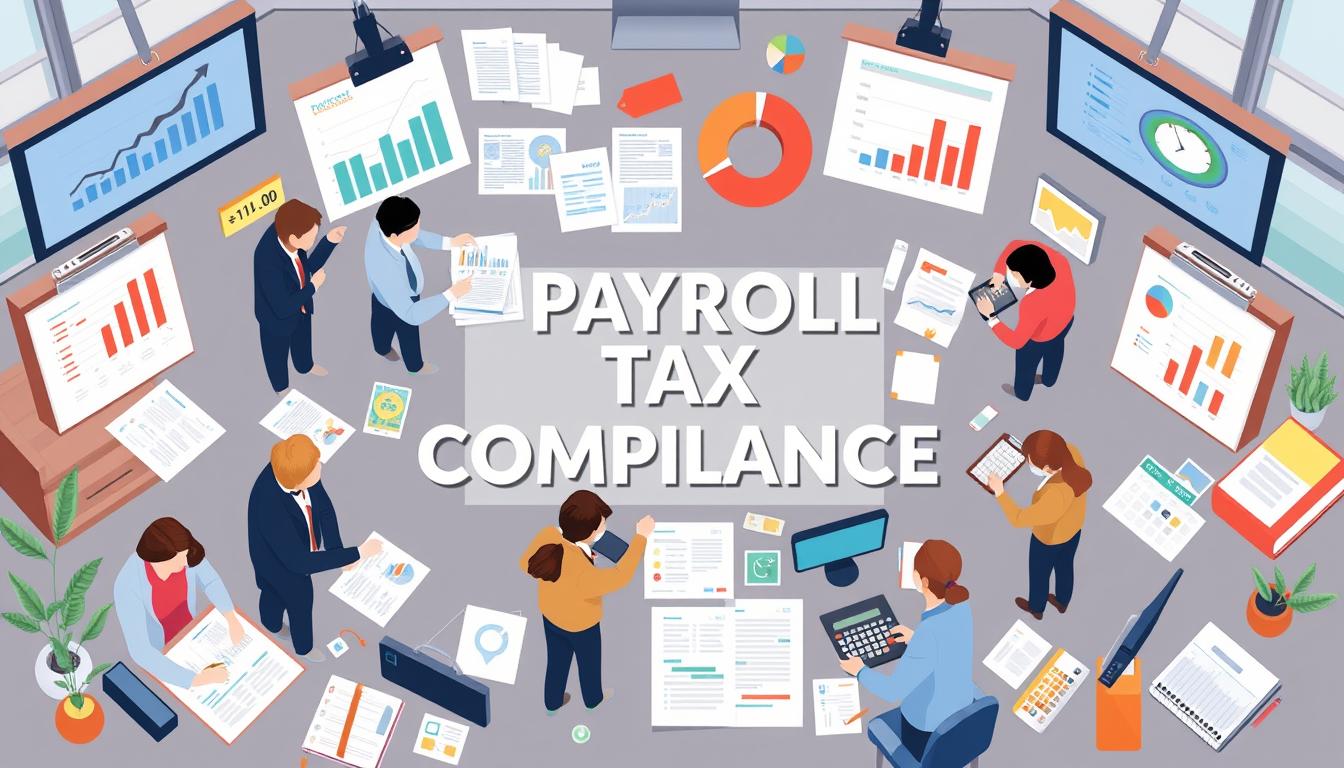Imagine waking up each day, feeling a sense of control over your finances. You know your hard-earned money is working for you, not the other way around. This peace of mind, rooted in solid tax planning, can empower you to make decisions that enhance your financial health and secure your future. In a world where tax laws seem daunting, understanding tax optimization can put more savings in your pocket. It’s more than just numbers; it’s about crafting a strategy that aligns with your life goals, reducing your tax liabilities while maximizing benefits to help you achieve financial stability. Smart tax strategies can lead to significant changes in your financial trajectory, making the journey smoother and more predictable. Start on the path to a better tomorrow and take charge of your financial destiny through effective tax planning, as this is crucial for optimizing finances, securing the future, and simplifying your financial journey1.
Key Takeaways
- Tax planning can lead to more savings and increase financial well-being.
- Maximizing deductions helps you keep more of your hard-earned money.
- Leveraging tax credits can enhance overall savings significantly.
- Understanding tax laws is essential for effective financial strategies.
- Smart tax planning can minimize tax liabilities while optimizing savings.
- Utilizing available tax tools can support effective tax planning efforts.
Understanding Tax Planning Basics
Tax planning involves evaluating your financial situation to ensure you are reducing tax liability while maximizing your potential tax benefits. This process includes understanding the various components of tax, which can be categorized into different types. There are four basic types of tax planning: Permissive Tax Planning, Purposive Tax Planning, Short-Term Tax Planning, and Long-Term Tax Planning2. Each type offers unique strategies to help with financial organization and future planning.
What is Tax Planning?
Tax planning can be defined as forecasting your financial scenario to align with tax obligations optimally. This includes assessing all possible income sources, identifying deductible expenses, and leveraging tax credits effectively. Tax planning is not limited to just saving taxes now; it plays a significant role in establishing a steady income stream and future financial success by avoiding unnecessary taxes3. By doing so, you can keep more of your earnings and ensure your retirement savings are working towards maximizing your financial growth.
Why is Tax Planning Important?
Engaging in effective tax planning allows you to protect your income and reduce overall tax liabilities significantly. For high-income earners, methods such as Tax Loss Harvesting, Charitable Giving, and Income Deferral can be vital2. Understanding which tax strategies—like retirement account contributions and utilizing tax credits—apply to your situation helps reduce taxable income3. Ultimately, tax planning empowers you to make informed decisions that will affect your net earnings and enhance your financial stability.

Key Components of Tax Planning
Understanding the essential components of tax planning can help you maximize your tax benefits. Key strategies involve conducting a thorough income assessment, identifying applicable tax deductions, and making the most of tax credits. These elements play a significant role in your overall financial strategy.
Income Assessment
Accurate income assessment lays the foundation for effective tax planning. Knowing your total income allows you to identify the best ways to utilize tax deductions and credits, which can significantly impact your tax burden. For instance, federal income tax brackets for 2023 vary from 10% to 37%, adjusting based on your income level4. Being aware of your tax bracket aids in planning your finances more strategically.
Deductions and Exemptions
Tax deductions reduce your taxable income, leaving you with a lower tax bill. Typical deductions might include standard deduction amounts, which for 2022 and 2023 are as follows: Single ($12,950 – $13,850), Married filing jointly ($25,900 – $27,700), and Head of household ($19,400 – $20,800)4. Additionally, understanding and claiming deductions such as those for research and development can provide notable tax incentives5. Following a strategic approach can enhance after-tax cash flows and financial stability.
Tax Credits
Tax credits directly reduce the amount of tax you owe, making them highly valuable. Examples of available tax credits include the Opportunity Zones and the Energy Efficient Home Credit4. Utilizing credits effectively can lead to significant savings, emphasizing the importance of strategic tax planning to take full advantage of available options. It is essential to stay updated with evolving tax laws to maximize your credits and deductions while ensuring compliance5.

Common Tax Planning Strategies
Effective tax planning involves various strategies that can significantly influence your financial standing. You can enhance your tax efficiency and maximize savings by implementing specific approaches such as utilizing tax-advantaged accounts, timing your income and expenses, and making thoughtful charitable contributions.
Utilize Tax-Advantaged Accounts
Tax-advantaged accounts, including Traditional IRAs and HSAs, can provide significant benefits. Contributions to these accounts can lower your taxable income while you save for retirement or healthcare expenses. For 2024, the contribution limit for a Traditional IRA is $7,000, with an extra $1,000 catch-up for individuals aged 50 or older6. Additionally, the maximum contribution for 401(k) plans is $23,000 in 2024, allowing you to save substantially while enjoying tax benefits6.
Timing Income and Deductions
Smart timing of income and deductions can enhance tax strategies significantly. For instance, if you expect to be in a lower tax bracket next year, consider delaying income until that year, possibly from bonuses or freelance work. This tactic can help optimize your total taxable income and reduce overall tax liability. It’s essential to stay informed about regulatory changes and adjust your strategy accordingly for effective planning7.
Charitable Contributions
Charitable giving not only fulfills personal values but also offers excellent tax advantages. Taxpayers can deduct cash donations to qualified charities up to 60% of their adjusted gross income, creating substantial possibilities for tax efficiency6. Furthermore, individuals aged 70½ or older can donate up to $105,000 from their IRA through a Qualified Charitable Distribution (QCD), creating another layer of tax benefits6. By making strategic charitable contributions, you can support causes you care about while lowering your taxable income.

The Role of Tax Professionals
Navigating the complexities of tax planning can be a daunting task. Engaging tax professionals can make a significant difference in achieving your financial goals. These specialists offer invaluable tax advice tailored to your individual needs, helping you to optimize your financial planning.
When to Hire a Tax Professional
Knowing when to bring in a tax professional can elevate your financial strategy. If you encounter complex tax situations, such as starting a business or managing multiple income streams, it’s wise to consult an expert. Significant life changes, like marriage or retirement, are also key moments to seek guidance. According to a study by the National Society of Accountants, tax preparers earn nearly $180 per hour for state or federal tax returns, highlighting their expertise8. Hiring a seasoned tax advisor can ensure you’re maximizing your tax benefits and maintaining compliance with evolving regulations.
Benefits of Consulting with Experts
Consulting with tax professionals can yield various benefits, from enhanced savings to peace of mind. Tax planning services can get you organized and equip you with advanced strategies for minimizing liabilities. Notably, 74% of tax professionals offer tax planning services, yet only 62% charge for them9. The average annual fee for tax planning services is $2,351 per client, which reflects the value these professionals bring9. Engaging a tax advisor not only helps in crafting a tailored financial strategy but can significantly improve your overall financial wellness.

In addition, studies indicate tax professionals spend about 2.3 hours preparing an average tax plan, underscoring their dedication to delivering quality service9. With a growing number of firms looking to integrate tax advisory services into their offerings, you can expect a greater focus on personalized financial strategies9. Overall, leveraging the expertise of tax professionals allows you to navigate the financial landscape more effectively and could lead to greater overall savings.
| Factor | Details |
|---|---|
| Average Fee for Tax Planning | $2,351 per client per year9 |
| Hourly Rate of Tax Preparers | Nearly $1808 |
| Average Annual Salary of Tax Preparers | $49,5508 |
| Growth Rate of Tax Preparers (2022-2032) | 1.5%8 |
Tax Planning for Individuals
Effective tax planning for individuals involves knowing your filing status, which has a significant impact on your tax rates and the deductions available to you. You can choose between several filing statuses, including single, married filing jointly, and head of household. Each status not only affects your tax rate but also influences the standard deduction you can claim, which for 2023 is $13,850 for single filers and $27,700 for married couples filing jointly10. Understanding these details can guide you in developing tax strategies for individuals that optimize your tax situation while complying with regulations.
Filing Status and Its Impact
Your filing status is crucial in determining your tax liability. For instance, tax brackets in the United States range from 10% to 37%, with seven distinct categories10. Knowing your status helps you project your tax obligations accurately and potentially leverage available deductions and credits. An effective approach is to periodically review your filing status as significant life events like marriage or having children can alter your optimal strategy.
Retirement Account Strategies
Incorporating retirement planning into your tax strategies for individuals is essential. Contributing to retirement accounts such as 401(k)s allows you to reduce your taxable income significantly. In 2024, you can contribute up to $23,000, with an extra $7,500 if you are 50 or older10. Understanding the implications of utilizing a Roth IRA versus a traditional IRA is vital, as Roth contributions grow tax-free while traditional IRA distributions are subject to taxation10. Therefore, tailoring your retirement strategies not only builds your future savings but also minimizes immediate tax liabilities.

| Filing Status | Standard Deduction (2023) | Tax Rate Ranges |
|---|---|---|
| Single | $13,850 | 10% – 37% |
| Married Filing Jointly | $27,700 | 10% – 37% |
| Head of Household | $20,800 | 10% – 37% |
By strategically selecting your filing status and efficiently utilizing retirement accounts, you can create a well-rounded tax planning approach that aligns with your financial goals. This proactive stance helps you manage tax obligations while preparing for a secure financial future。11
Tax Planning for Businesses
Engaging in effective business tax planning is essential for maximizing profitability and ensuring compliance. Understanding how your business structure impacts taxes is crucial. Different entities entail varying tax implications and opportunities for tax deductions.
Business Structure and Taxes
Choosing the right business structure, be it a sole proprietorship, partnership, C-corporation, or S-corporation, can yield significant tax advantages. For instance, C-corporations face a flat 21% corporate tax rate on income before distributions, while pass-through entities allow profits to be taxed at individual rates. Many small business owners are aware that they can benefit from the 20% deduction for qualified business income under the 2017 Tax Cuts and Jobs Act until it expires in 202512. Furthermore, states have begun implementing Pass-Through Entity (PTE) taxes to circumvent limitations on state and local tax deductions, potentially benefiting business operations13.
Deductible Business Expenses
Being aware of deductible business expenses is vital in improving cash flow and enhancing business viability. Business owners can accelerate deductions in the current year to lower taxable income. Some common deductible expenses include:
- Employee salaries and wages
- Rent or lease payments
- Utilities and office supplies
- Depreciation on property
- Health insurance premiums, which can qualify for the Small Business Health Care Tax Credit
In addition, charitable contributions might be more beneficial when utilizing an irrevocable charitable remainder unitrust (CRUT), which allows for deferral of capital gains taxes13. By strategically planning your tax deductions, you can significantly bolster your business’s financial footing and prepare for potential tax changes in 2026 and beyond12.

The Impact of Life Changes on Tax Planning
Major life changes can significantly affect your tax planning strategies. Events such as marriage or the addition of children may bring about important tax implications that require careful consideration. Adjusting your tax approach can enhance your overall financial situation and improve your family planning strategy.
Tax Implications of Marriage
Marriage often changes your filing status, which can lead to different tax liabilities compared to single status. For married couples filing jointly, the income ceiling for Roth IRA contributions in 2022 is $214,000, up from $208,000 in 202114. The opportunity for tax exclusions, such as up to $500,000 in capital gains from selling a primary residence, is also attractive for married couples15. Understanding these benefits is crucial for effective tax planning.
Adjustments after Having Children
Welcoming new children into the family introduces various tax implications related to qualified education savings. For instance, individuals can contribute up to $80,000 to a 529 plan over five years without incurring gift tax, while married couples can contribute up to $160,00014. Additionally, securing necessary deductions and credits for children can enhance your tax situation. You may also consider how changes in your household can influence your savings and investments.

| Life Change | Tax Implications | Planning Strategies |
|---|---|---|
| Marriage | Changes in filing status, potential tax benefits | Assess joint versus single status benefits, maximize available credits |
| Having Children | Qualifying for child tax credits, education savings options | Utilize 529 plans, plan for future education expenses |
Understanding tax implications during significant life changes is essential for effective family planning and achieving financial goals14.
Using Tax Software for Planning
Tax software has revolutionized the way individuals and businesses approach their tax planning and filing. By integrating advanced tax planning tools, these programs significantly enhance your ability to maintain organized financial records while maximizing deductions. Most importantly, they facilitate efficient filing to ensure a smoother tax season.
Benefits of Tax Software
Utilizing tax software can lead to substantial tax savings. For example, average tax savings can exceed $35,000 annually when employing expert tax planning paired with advanced software tools16. Furthermore, programs like Tax Planner Pro automate tax projections that update weekly, perfectly accommodating changes in your business financials17. This automation can save hours for accountants while providing them with precise strategies aimed at reducing tax liabilities significantly.
Another remarkable benefit is the ability to track new planning revenues as a Key Performance Indicator, linking your tax strategies directly to your financial growth. The emphasis on a Return on Investment (ROI) through a Fees to Savings Dashboard allows users to visualize the performance of their tax plans16. This comprehensive approach makes tax software not just a tool but a critical partner in effective tax management.
Top Tax Software Recommendations
When seeking suitable tax software, it is essential to consider options that deliver both effectiveness and user-friendliness. Here are some popular recommendations:
| Software | Key Features | Average Cost |
|---|---|---|
| Tax Planner Pro | Weekly updates, custom tax plans, syncs multiple businesses | $2,500 – $1,000,000 per plan |
| TurboTax | Simple interface, extensive guidance, e-filing | Starting around $60 |
| H&R Block | Live support, advanced Deductions Finder, easy-to-navigate | Starting around $70 |
These software tools provide unique advantages tailored to various needs. Selecting the right one can greatly enhance your tax efficiency and planning capabilities.

Integrating these software options into your tax strategy can yield personalized and streamlined results, ultimately assisting you in achieving your financial objectives with greater confidence.
In conclusion, employing appropriate tax software can empower you to optimize your tax planning efforts while ensuring a seamless filing process. Experts emphasize that human expertise remains crucial, complementing the efficiency provided by tax software solutions16. Embrace the future of tax management by leveraging technology to enhance your financial future1617.
Understanding Capital Gains Tax
Capital gains tax plays a significant role in your investment strategy, affecting how much you ultimately keep from your profits when you sell assets. Capital gains occur when the value of an asset increases, and you profit upon its sale. Understanding the distinction between short-term and long-term capital gains is essential, as it directly influences your tax obligations.
What are Capital Gains?
Capital gains are profits realized from the sale of assets, such as stocks, bonds, real estate, and collectibles. If you hold an asset for less than a year, any gain from its sale is considered a short-term capital gain and is taxed as ordinary income, which typically has a higher rate than long-term gains18. In contrast, gains from assets held for more than a year qualify as long-term capital gains, which are taxed at lower rates—0%, 15%, or 20%, depending on your taxable income and filing status for the 2025 tax year1920.
Strategies to Minimize Capital Gains Tax
Employing smart tax strategies can significantly reduce your capital gains tax burden. Here are several approaches to consider:
- Hold assets longer: Holding investments for over a year allows you to take advantage of lower long-term capital gains rates.
- Utilize tax-advantaged accounts: Tax-deferred accounts like Roth IRAs and 529 plans exempt capital gains tax under certain conditions18. Traditional 401(k)s and IRAs allow tax deferral on gains until withdrawal, typically after age 59 ½.
- Offset gains with losses: You can use capital losses to offset your capital gains, thus reducing your overall tax liability1820.
- Consider the timing of your sales: Strategically timing when you sell your investments can lower your tax bracket for the year, minimizing your capital gains tax.
Be mindful of the “wash sale” rule, which disallows claiming losses on securities sold and then repurchased within a 30-day period. This strategy ensures your tax situation remains manageable and compliant with IRS regulations.

State-Specific Tax Planning
Understanding state-specific tax obligations can significantly impact your financial health. Tax obligations vary greatly across states, making it essential to tailor your state tax planning strategies according to local laws. Each state offers unique credits, deductions, and incentive programs that can benefit you, especially if you own a small business or reside in a high-tax area.
Understanding State Tax Obligations
In 2023, New Jersey became the first state to adopt the economic nexus standard for both corporation business taxes and sales taxes, impacting businesses with $100,000 in sales or 200 transactions21. Additionally, 36 states, including New Jersey and New York, have passed legislation to sidestep the $10,000 state and local tax (SALT) deduction limitation21. The IRS has confirmed that pass-through entity tax (PTET) elections provide an effective workaround for this SALT limitation21. It’s vital to stay informed about these regulations, as they can influence your local tax obligations.
How to Plan for State Taxes
Exploring state taxes can unveil numerous tax credits and incentives targeting small and mid-size businesses21. For individuals considering relocation to maximize tax savings, nine states in the U.S. boast no state income tax—these include Alaska, Florida, Nevada, New Hampshire, South Dakota, Tennessee, Texas, Washington, and Wyoming22. Residents of these states can save significantly by timing the sale of appreciated assets to coincide with establishing residency22. Engaging a tax professional is essential, given the varying rules about residency and taxation across states, particularly if you’re a high earner in a high-tax state22.

The Importance of Record Keeping
Effective record keeping plays a vital role in tax planning and compliance. It ensures you have organized financial records, assisting during tax preparation and verification for claims on deductions and credits. Establishing a system for proper tax documentation protects you from potential audits and helps maintain accurate financial practices.
Organizing Financial Records
Start by categorizing your financial records into segments such as income, expenses, and tax documents. The IRS recommends keeping your records for at least three years from the date of filing your tax return. This duration applies to general tax records, while employment tax records should be secured for four years after the tax due date or payment, whichever comes later2324. If you’re claiming losses from worthless securities, records must be retained for seven years, whereas any underreported income exceeding 25% of gross income requires keeping records for six years24.
Tools for Efficient Record Keeping
Leveraging digital tools can significantly enhance your record-keeping efforts. Software tailored for financial management can streamline the organization of financial records and enable easier retrieval during tax season. It’s essential to ensure that electronic records maintain a complete and accurate account of your financial data, as required for IRS review24. Additionally, keeping detailed property records aids in calculating gains or losses during property dispositions, which is crucial for accurate reporting.

Utilizing these methods not only improves your financial organization but also supports your tax documentation needs effectively. Good record keeping allows you to identify sources of income, track expense deductions, and substantiate claims made on tax returns23.
Navigating Tax Law Changes
Staying informed about tax law changes is crucial for effective financial planning. Tax updates can significantly influence both individual and business strategies. It is essential to understand how these shifts affect your planning adjustments to maintain compliance and optimize your tax outcomes.
Staying Updated with Tax Laws
Tax laws, such as those instituted by the Tax Cuts and Jobs Act (TCJA) in 2017, highlight the importance of keeping abreast of recent developments as many provisions are set to expire at the end of 202525. Tax professionals should actively monitor legislative landscapes to prepare for potential financial ramifications stemming from policy changes25. The recent U.S. election results may herald notable changes in tax policies that could affect procedural frameworks for tax professionals to navigate25.
How Changes Affect Your Planning
Planning adjustments are often necessary following tax updates. Resources like downloadable guides that categorize expiring provisions under the TCJA help clarify the current terms and expected changes26. A comprehensive understanding aids both taxpayers and professionals alike in making informed financial decisions. Furthermore, exclusive webcasts and podcasts on multi-year income tax planning provide valuable insights into handling ongoing changes effectively26.

| Aspect | TCJA Impact | Future Considerations |
|---|---|---|
| Standard Deductions | Increased significantly to benefit individuals | Potential expiration after 2025 |
| Child Tax Credit | Enhanced amounts available for families | Review for potential adjustments |
| Corporate Tax Rate | Reduced rate aimed at domestic manufacturers | Possibility of further policy changes |
| Pass-Through Entity Tax | Specific deductions available | Changes operational dynamics for planning |
Staying proactive in your tax planning allows for seamless adjustments as tax law changes unfold. Taking the time to familiarize yourself with the implications of these shifts will enable you to navigate the evolving landscape with confidence2526.
Year-Round Tax Planning Practices
Engaging in year-round planning enhances your financial health and promotes better tax efficiency. Regularly revisiting your financial strategy allows you to identify potential deductions and credits that may be overlooked. You can maximize tax benefits by staying proactive and adjusting your approach as needed throughout the year, particularly in response to life changes like marriage or the birth of a child, which can significantly influence your tax situation27.
The Benefits of Ongoing Planning
By implementing a structured year-round planning system, you can better manage your tax season goals. Consistent engagement with your financial status not only reduces stress during tax season but also ensures you are maximizing opportunities to lower your adjusted gross income (AGI). Awareness of your financial standing allows for adjustments that can lower your tax liabilities, making for smoother financial management overall27.
Setting Goals for Each Tax Season
Establishing specific, measurable goals for each tax season helps you stay focused and accountable. Consider key areas such as ensuring adequate withholding throughout the year, as changes in personal circumstances can necessitate adjustments to avoid owing money when filing27. Setting aside funds for retirement can further contribute to tax efficiency, leading to potential reductions in taxable income27.

| Planning Aspect | Benefit | Action Item |
|---|---|---|
| Life Changes | Adjust filing status | Review eligibility for credits/deductions |
| Withholding | Avoid unexpected tax bills | Monitor paychecks, adjust withholdings |
| Retirement Contributions | Lower AGI, reduce taxable income | Maximize contributions to retirement accounts |
Taking these actions can significantly enhance your tax efficiency, leading to less stress during the tax season.
Tracking your financial progress and understanding how to adjust your tactics throughout the year ensures that you can meet your tax season goals effectively, setting you on a path to success as each season approaches2829.
Avoiding Common Tax Planning Mistakes
Understanding and anticipating potential tax planning mistakes is essential for effectively managing your finances. It is vital to recognize common errors to significantly reduce your tax liability.
Misunderstanding Tax Deductions
One prevalent mistake involves misunderstanding tax deductions, which can lead to missed opportunities for savings. Many taxpayers often confuse eligible deductions, such as mortgage interest and state taxes, with non-deductible expenses, which may result in overreporting their income. The tax code provides various options for deductions like charitable contributions, yet it is essential to know whether to itemize or take the standard deduction as this choice can impact your overall tax liability significantly30.
Procrastination in Planning
Procrastinating on tax planning can lead to rushed decisions and higher costs. It’s crucial to implement proactive tax strategies throughout the year rather than waiting until tax season. For instance, adjusting withholding amounts and taking time to organize your financial documents can help streamline the filing process and avoid common errors30. Creating a year-round plan enables you to take advantage of opportunities like maximizing retirement contributions, which, for example, could save a dual-physician household around $28,000 by reducing their tax liability31.

Overall, being aware of tax planning mistakes will allow you to maintain better control over your financial future313230.
Future Trends in Tax Planning
As you navigate the evolving landscape of tax planning, staying informed about the latest tax planning trends is crucial. Economic impacts significantly influence tax strategies and forecasting practices. By paying attention to potential future predictions regarding tax laws, you can position yourself or your business for success amidst changing regulations.
How the Economy Affects Tax Strategies
The current economic environment has a major influence on tax strategies utilized by both individuals and corporations. New regulations aim at multinational companies with consolidated financial statement revenue exceeding 750 million euros in at least two of the previous four years due to the implementation of Pillar 2 global minimum tax33. The foreign income of U.S. multinationals may now encounter challenges due to laws such as the Qualified Domestic Minimum Top-Up Tax and the Under-Taxed Profits Rule, impacting operations in foreign jurisdictions33. Furthermore, with imports and exports between related parties surpassing $2 trillion, effective transfer pricing strategies become imperative33.
Predictions for Upcoming Tax Laws
The tax landscape is anticipated to evolve with ongoing digital transformation and automation in the taxation sector. Tax professionals are leveraging advanced software for compliance, data analysis, and reporting purposes34. Remote work trends catalyzed by the pandemic have prompted increased reliance on virtual collaboration tools and cloud-based platforms34. Additionally, cryptocurrency taxation is expected to see heightened scrutiny as its popularity rises, necessitating tax advisors to be proficient in the treatment of digital assets34.

Public companies face new tax liabilities, such as a 1% excise tax on stock repurchases that will take effect in 202333. As economic nexus provisions continue to evolve, state and local taxes are increasingly targeting service providers and digital goods33. Tax authorities are placing heightened scrutiny on tax planning strategies, emphasizing transparent and ethical practices across the board34. With these dynamic changes, aligning your tax strategies for resilience will be paramount.
Conclusion: Take Control of Your Taxes
As this guide draws to a close, it’s essential to prioritize the steering of your tax planning processes. To truly take control of your taxes, start by evaluating your current financial situation and setting clear goals regarding your tax strategies. Consider utilizing tax-advantaged accounts, such as IRAs and 401(k)s, which allow for significant contributions—$6,500 for an IRA for those under 50 in 2023 and $22,500 for 401(k) contributions—both increasing in 20243536. These steps contribute to your financial empowerment and can lead to long-term savings and reduced tax liabilities.
Your Next Steps in Tax Planning
To advance in your tax planning journey, it is crucial to be proactive year-round rather than just during tax season, ensuring that your strategies adapt to changes in your life circumstances, such as marriage, children, or retirement36. Additionally, familiarize yourself with the various available tax credits, such as the child tax credit and earned income tax credit, which can significantly lower your taxable income37. If you are aiming for sustainable outcomes, implementing strategies like capital loss harvesting could further enhance your approach to managing taxes on investments.
Resources for Continued Learning
Enhancing your understanding of tax planning resources will serve you well in navigating the complexities of tax laws. Commit to continuous learning through reputable personal finance books, online courses, and workshops focused on effective tax strategies. Remember to keep a detailed record of your financial information, as an organized approach facilitates better tax decisions and compliance with tax obligations37.
FAQ
What is tax planning?
Why is tax planning important?
What are some common tax deductions?
How do tax credits work?
What are tax-advantaged accounts?
When should I consider hiring a tax professional?
How can major life events affect my tax planning?
What are capital gains, and why are they important?
How do I keep track of tax documentation?
How can I stay updated on tax law changes?
What are some common mistakes to avoid in tax planning?
Source Links
- https://tax-titans.com/smart-tax-planning/ – Optimize Finances with Smart Tax Planning
- https://www.360financial.net/tax-planning-guide – Tax Planning Guide – Simple Tax Planning Tips from an Advisor
- https://www.schwab.com/taxes/tax-basics – Tax basics: How to Plan Year-Round
- https://mycpacoach.com/blog/what-is-tax-planning/ – What Is Tax Planning? A Beginner’s Guide To Reduce Taxes
- https://msaonline.depaul.edu/blog/strategic-tax-planning – Strategic Tax Planning: Essential Tips for Corporate Tax Efficiency
- https://www.schwab.com/learn/story/year-end-portfolio-checkup-5-tax-smart-tips – Tax-Saving Moves You Can Make Before Year-End
- https://www.goldenappleagencyinc.com/blog/top-tax-planning-strategies – 10 Top Tax Planning Strategies to Know
- https://www.accounting.com/careers/tax-preparer/ – What Do Tax Preparers Do? | Accounting.com
- https://proconnect.intuit.com/taxprocenter/wp-content/uploads/2021/12/Radius-2021-Tax-Planning-and-Advisory-Insights-Intuit-Accountants-Survey.pdf – PDF
- https://www.nerdwallet.com/article/taxes/tax-planning – Tax Planning: 7 Tax Strategies to Consider – NerdWallet
- https://tax.thomsonreuters.com/blog/how-to-implement-effective-tax-planning-for-individuals/ – How to implement effective tax planning for individuals
- https://www.ml.com/articles/tax-tips-for-small-business-owners.html – Tax Tips and Strategies for Small Business Owners
- https://www.cnb.com/business-banking/insights/small-business-tax-planning-strategies.html – Tax Planning Strategies for Small Businesses | City National Bank
- https://summitry.com/blog/6-major-life-changes-that-impact-your-taxes/ – 6 Major Life Changes that Impact Your Taxes – Summitry
- https://www.cbmcpa.com/2024/09/23/life-transitions-tax-planning-part-ii/ – The Impact of Significant Life Transitions on Tax Planning (Part II) – Councilor, Buchanan & Mitchell (CBM)
- https://certifiedtaxcoach.org/tax-planning-software/ – Tax Planning Software for Individuals – Tru Tax Planner
- https://www.taxplannerpro.com/ – Tax Planner Pro: Professional Tax Planning Software
- https://www.finra.org/investors/insights/capital-gains-explained – Capital Gains Explained
- https://www.investopedia.com/terms/c/capital_gains_tax.asp – Capital Gains Tax: What It Is, How It Works, and Current Rates
- https://www.cnb.com/personal-banking/insights/understanding-capital-gains-tax.html – Understanding Capital Gains Tax: 2024 Rates | City National Bank
- https://www.withum.com/resources/state-and-local-year-end-tax-planning/ – Year-End State and Local Tax Planning
- https://opeswealth.com/planning-a-move-to-a-new-state-consider-these-state-income-tax-strategies/ – Planning a Move to a New State? Consider These State Income Tax Strategies – OPES Wealth
- https://www.irs.gov/newsroom/the-first-step-of-good-tax-planning-is-good-recordkeeping – The first step of good tax planning is good recordkeeping
- https://www.wolterskluwer.com/en/expert-insights/tax-planning-recordkeeping-for-small-businesses – Tax Planning: Recordkeeping for Small Businesses
- https://tax.thomsonreuters.com/blog/navigating-political-changes-in-the-evolving-tax-landscape/ – Navigating political changes in an evolving tax landscape
- https://www.aicpa-cima.com/resources/landing/planning-for-tax-changes – Planning for tax changes
- https://www.irs.gov/newsroom/year-round-tax-planning-pointers-for-taxpayers – Year-round tax planning pointers for taxpayers
- https://www.usbank.com/wealth-management/financial-perspectives/financial-planning/tax-tips-to-remember-year-round.html – Tax Planning Tips | U.S. Bank
- https://mccarthylebit.com/the-benefits-of-year-round-tax-planning/ – The Benefits of Year-Round Tax Planning
- https://www.ameriprise.com/financial-goals-priorities/taxes/proactive-tax-planning – Proactive tax planning
- https://wealthkeel.com/blog/avoid-these-5-tax-mistakes/ – Avoid These 5 Tax Mistakes – Real Life Examples!
- https://www.knowify.com/blog/construction-tax-planning-mistakes/ – 4 common tax planning mistakes in construction (and how to avoid them) – Knowify
- https://www.grantthornton.com/insights/articles/tax/2023/tax-planning-for-businesses-heading-into-2024 – What’s old is new: Tax planning for businesses heading into 2024 | Grant Thornton
- https://cpe.ucdavis.edu/news/top-accounting-trends-2024-and-beyond – Top Accounting Trends for 2024 and Beyond
- https://www.investopedia.com/terms/t/tax-planning.asp – Tax Planning: What It Is, How It Works, Examples
- https://www.affiancefinancial.com/news/tax-planning-or-tax-preparation-which-do-i-need – Tax Planning or Tax Preparation: Which Do I Need?
- https://www.hco.com/insights/income-tax-planning-strategies – Income Tax Strategies For Individuals









